-
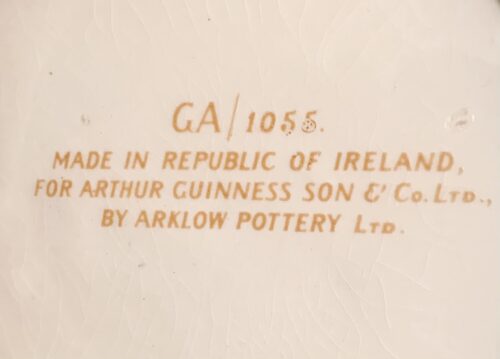
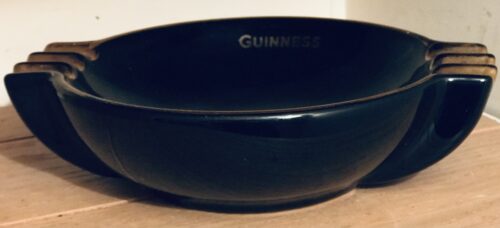 Beautiful,rare unusual 1960s Guinness ashtray made by Arklow Pottery in Co Wicklow. 23cm x 18cm x 7cm Arklow Pottery was a pottery founded in 1934 and formally opened by Seán Lemass (Minister for Industry and Commerce) 29 July 1935 in South Quay, Arklow, County Wicklow, Ireland. The company produced many decorative earthenware goods and general table crockery. Arklow Pottery ran into financial difficulties in the 1970s and was taken over by Japanese tableware company Noritake in 1977. After losses of more than £7.5 million over a 20-year period, the company ceased production in 1998. At its peak the company had employed 480 people.There is an Arklow Pottery cup and saucer with Tiger stripes, designed by John French around 1950, held and exhibited by the National Museum of Ireland. Arklow pottery is now closed. Origins : Co Wicklow Dimensions :18cm x 23cm
Beautiful,rare unusual 1960s Guinness ashtray made by Arklow Pottery in Co Wicklow. 23cm x 18cm x 7cm Arklow Pottery was a pottery founded in 1934 and formally opened by Seán Lemass (Minister for Industry and Commerce) 29 July 1935 in South Quay, Arklow, County Wicklow, Ireland. The company produced many decorative earthenware goods and general table crockery. Arklow Pottery ran into financial difficulties in the 1970s and was taken over by Japanese tableware company Noritake in 1977. After losses of more than £7.5 million over a 20-year period, the company ceased production in 1998. At its peak the company had employed 480 people.There is an Arklow Pottery cup and saucer with Tiger stripes, designed by John French around 1950, held and exhibited by the National Museum of Ireland. Arklow pottery is now closed. Origins : Co Wicklow Dimensions :18cm x 23cm -
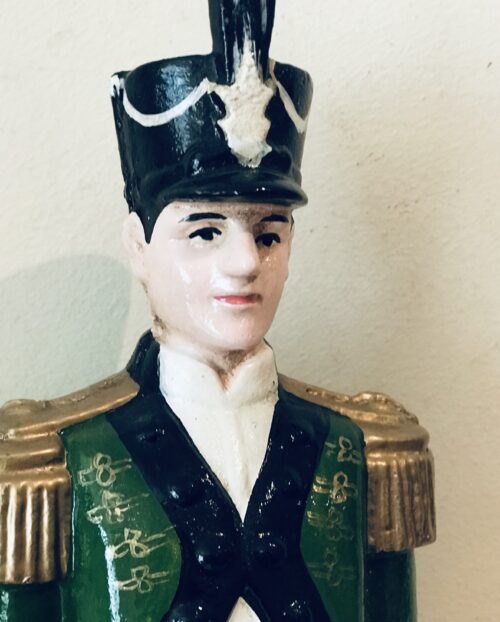
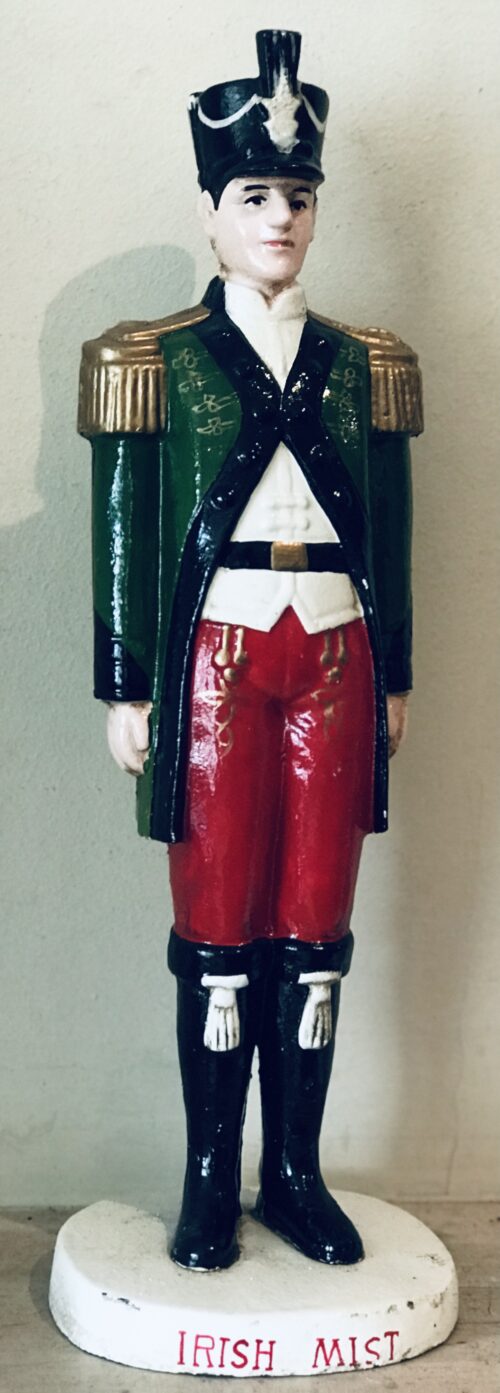 A beautiful and superbly made cast iron reproduction of an Irish Mist Decanter bottle ,the iconic Irish soldier dressed in the traditional Irish Brigade of the Austrian Army uniform of 1750. 39cm x 14cm x 12cm. 3kg Irish Mist is a brown Whiskey Liqueur produced in Dublin, Ireland, by the Irish Mist Liqueur Company Ltd. In September 2010 it was announced that the brand was being bought by Gruppo Campari from William Grant, only a few months after Grants had bought it from the C&C Group. It is made from aged Irish whiskey, heather and clover honey, aromatic herbs, and other spirits, blended to an ancient recipe claimed to be 1,000 years old.Though it was once 80 US proof (40% alcohol per volume), Irish Mist is now 35% or 70 US proof. The bottle shape has also been changed from a "decanter" style to a more traditional whiskey bottle shape. It is currently available in more than 40 countries. Irish Mist was the first liqueur to be produced in Ireland when commercial production began in 1947 at Tullamore, County Offaly. Tullamore is the hometown of the Williams family who were the original owners of Irish Mist. The company history goes back to 1829 when the Tullamore Distillery was founded to produce Irish whiskey. In the mid-1940s Desmond E. Williams began the search for an alternative yet related product, eventually deciding to produce a liqueur based on the ancient beverage known as heather wine.In 1985 the Cantrell & Cochrane Group purchased the Irish Mist Liqueur Company from the Williams family. In the summer of 2010 Irish Mist and the entire spirit division of C&C was bought by William Grant of Scotland. In September 2010 they in turn sold Irish Mist to Gruppo Campari.Irish Mist is typically served straight up or on ice, but also goes with coffee, vodka, or cranberry juice. Per the makers, Irish Mist's most popular recipe is Irish Mist with Cola and Lime. A Rusty Mist is an ounce of Irish Mist with an ounce of Drambuie Scotch whisky liqueur.A Black Nail is made from equal parts Irish Mist and Irish whiskey.
A beautiful and superbly made cast iron reproduction of an Irish Mist Decanter bottle ,the iconic Irish soldier dressed in the traditional Irish Brigade of the Austrian Army uniform of 1750. 39cm x 14cm x 12cm. 3kg Irish Mist is a brown Whiskey Liqueur produced in Dublin, Ireland, by the Irish Mist Liqueur Company Ltd. In September 2010 it was announced that the brand was being bought by Gruppo Campari from William Grant, only a few months after Grants had bought it from the C&C Group. It is made from aged Irish whiskey, heather and clover honey, aromatic herbs, and other spirits, blended to an ancient recipe claimed to be 1,000 years old.Though it was once 80 US proof (40% alcohol per volume), Irish Mist is now 35% or 70 US proof. The bottle shape has also been changed from a "decanter" style to a more traditional whiskey bottle shape. It is currently available in more than 40 countries. Irish Mist was the first liqueur to be produced in Ireland when commercial production began in 1947 at Tullamore, County Offaly. Tullamore is the hometown of the Williams family who were the original owners of Irish Mist. The company history goes back to 1829 when the Tullamore Distillery was founded to produce Irish whiskey. In the mid-1940s Desmond E. Williams began the search for an alternative yet related product, eventually deciding to produce a liqueur based on the ancient beverage known as heather wine.In 1985 the Cantrell & Cochrane Group purchased the Irish Mist Liqueur Company from the Williams family. In the summer of 2010 Irish Mist and the entire spirit division of C&C was bought by William Grant of Scotland. In September 2010 they in turn sold Irish Mist to Gruppo Campari.Irish Mist is typically served straight up or on ice, but also goes with coffee, vodka, or cranberry juice. Per the makers, Irish Mist's most popular recipe is Irish Mist with Cola and Lime. A Rusty Mist is an ounce of Irish Mist with an ounce of Drambuie Scotch whisky liqueur.A Black Nail is made from equal parts Irish Mist and Irish whiskey. -
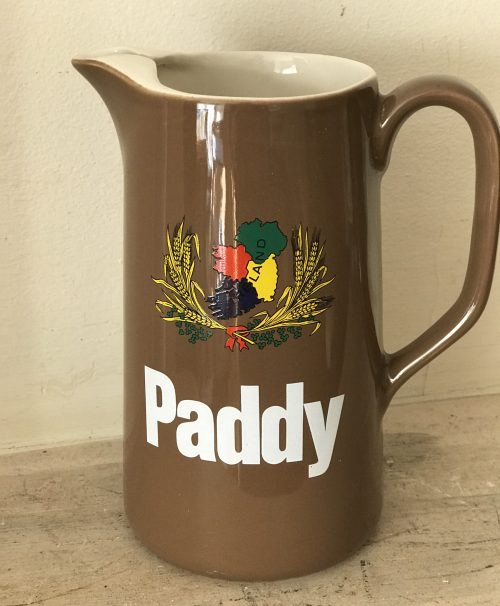
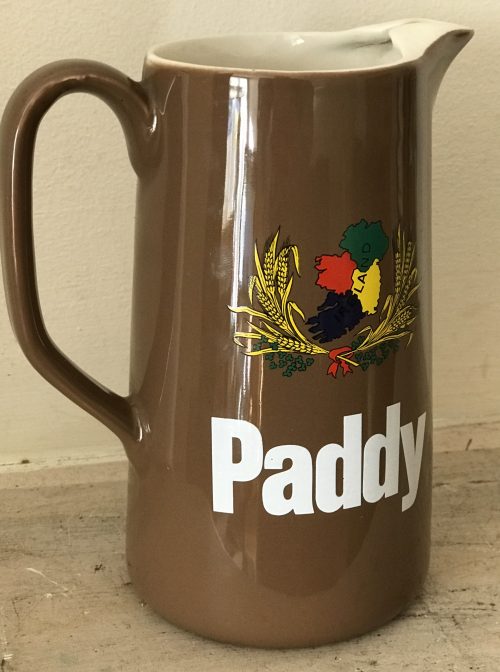 Really nice medium sized Paddy Old Irish Whiskey Jug Origins: Cork Dimensions :16cm x 12cm x 8cm
Really nice medium sized Paddy Old Irish Whiskey Jug Origins: Cork Dimensions :16cm x 12cm x 8cm
Paddy is a brand of blended Irish whiskey produced by Irish Distillers, at the Midleton distillery in County Cork, on behalf of Sazerac, a privately held American company. Irish distillers owned the brand until its sale to Sazerac in 2016. As of 2016, Paddy is the fourth largest selling Irish whiskey in the WorldHistory The Cork Distilleries Company was founded in 1867 to merge four existing distilleries in Cork city (the North Mall, the Green, Watercourse Road, and Daly's) under the control of one group.A fifth distillery, the Midleton distillery, joined the group soon after in 1868. In 1882, the company hired a young Corkman called Paddy Flaherty as a salesman. Flaherty travelled the pubs of Cork marketing the company's unwieldy named "Cork Distilleries Company Old Irish Whiskey".His sales techniques (which including free rounds of drinks for customers) were so good, that when publicans ran low on stock they would write the distillery to reorder cases of "Paddy Flaherty's whiskey". In 1912, with his name having become synonymous with the whiskey, the distillery officially renamed the whiskey Paddy Irish Whiskey in his honour. In 1920s and 1930s in Ireland, whiskey was sold in casks from the distillery to wholesalers, who would in turn sell it on to publicans.To prevent fluctuations in quality due to middlemen diluting their casks, Cork Distilleries Company decided to bottle their own whiskey known as Paddy, becoming one of the first to do so. In 1988, following an unsolicited takeover offer by Grand Metropolitan, Irish Distillers approached Pernod Ricard and subsequently became a subsidiary of the French drinks conglomerate, following a friendly takeover bid. In 2016, Pernod Ricard sold the Paddy brand to Sazerac, a privately held American firm for an undisclosed fee. Pernod Ricard stated that the sale was in order "simplify" their portfolio, and allow for more targeted investment in their other Irish whiskey brands, such as Jameson and Powers. At the time of the sale, Paddy was the fourth largest selling Irish whiskey brand in the world, with sales of 200,000 9-litre cases per annum, across 28 countries worldwide. Paddy whiskey is distilled three times and matured in oak casks for up to seven years.Compared with other Irish whiskeys, Paddy has a comparatively low pot still content and a high malt content in its blend. Jim Murray, author of the Whiskey bible, has rated Paddy as "one of the softest of all Ireland's whiskeys".

Introduced 1879, renamed as Paddy in 1912 -

 20cm diametre Dublin In the 1980s and 1990s, a number of areas in the Republic of Ireland held year-long festivals commemorating historic anniversaries. The country was in an economic depression at the time and these were excuses for some civic pride; the anniversaries chosen were often rather arbitrary and were chosen by the relevant local authority to promote tourism. The "Dublin millennium" was proposed by city manager Frank Feely to be held in 1988, commemorating Gaelic King Mael Seachlainn II's conquest of the Viking city of Dublin.The corporation agreed in December 1985, prompting a historian to point out that the conquest had actually occurred in 989 and to suggest the year "was chosen quite arbitrarily for the 'millennium' because it is coming up soon, not long after the Galway 500 and the Cork 800". A commemorative 50 pence piece was minted for general circulationFounding and early history of Dublin The earliest reference to Dublin is sometimes said to be found in the writings of Claudius Ptolemaeus (Ptolemy), the Egyptian-Greek astronomer and cartographer, around the year 140, who refers to a settlement called Eblana. This would seem to give Dublin a just claim to nearly two thousand years of antiquity, as the settlement must have existed a considerable time before Ptolemy became aware of it. Recently, however, doubt has been cast on the identification of Eblana with Dublin, and the similarity of the two names is now thought to be coincidental. It is now thought that the Viking settlement was preceded by a Christian ecclesiastical settlement known as Duiblinn, from which Dyflin took its name. Beginning in the 9th and 10th century, there were two settlements where the modern city stands. The Viking settlement of about 841 was known as Dyflin, from the Irish Duiblinn (or "Black Pool", referring to a dark tidal pool where the River Poddle entered the Liffey on the site of the Castle Gardens at the rear of Dublin Castle), and a Gaelic settlement, Áth Cliath ("ford of hurdles") was further upriver, at the present day Father Mathew Bridge at the bottom of Church Street. The Celtic settlement's name is still used as the Irish name of the modern city, though the first written evidence of it is found in the Annals of Ulster of 1368. The modern English name came from the Viking settlement of Dyflin, which derived its name from the Irish Duiblinn. The Vikings, or Ostmen as they called themselves, ruled Dublin for almost three centuries, although they were expelled in 902 only to return in 917 and notwithstanding their defeat by the Irish High King Brian Boru at the Battle of Clontarf in 1014. From that date, the Norse were a minor political force in Ireland, firmly opting for a commercial life. Viking rule of Dublin would end completely in 1171 when the city was captured by King Dermot MacMurrough of Leinster, with the aid of Cambro-Norman mercenaries. An attempt was made by the last Norse King of Dublin, Ascall mac Ragnaill, to recapture the city with an army he raised among his relations in the Scottish Highlands, where he was forced to flee after the city was taken, but the attempted reconquest failed and Ascall was killed.The Thingmote was a raised mound, 40-foot (12 m) high and 240-foot (73 m) in circumference, where the Norsemen assembled and made their laws. It stood on the south of the river, adjacent to Dublin Castle, until 1685.[4] Viking Dublin had a large slave market. Thralls were captured and sold, not only by the Norse but also by warring Irish chiefs.b Dublin celebrated its millennium in 1988 with the slogan Dublin's great in '88'. The city is far older than that, but in that year, the Norse King Glun Iarainnrecognised Máel Sechnaill II (Máel Sechnaill Mór), High King of Ireland, and agreed to pay taxes and accept Brehon Law.a That date was celebrated, but might not be accurate: in 989 (not 988), Mael Seachlainn laid siege to the city for 20 days and captured it. This was not his first attack on the city.[citation needed] Dublin became the centre of English power in Ireland after the Norman invasion of the southern half of Ireland (Munster and Leinster) in 1169–71, replacing Tara in Meath – seat of the Gaelic High Kings of Ireland – as the focal point of Ireland's polity. On 15 May 1192 Dublin's first written Charter of Liberties was granted by John, Lord of Ireland, and was addressed to all his "French, English, Irish and Welsh subjects and friends". On 15 June 1229 his son Henrygranted the citizens the right to elect a mayor who was to be assisted by two provosts.[5] By 1400, however, many of the Anglo-Norman conquerors were absorbed into the Gaelic culture, adopting the Irish language and customs, leaving only a small area of Leinster around Dublin, known as the Pale, under direct English control. Origins : Dublin Dimensions :Skudelev II, a large Viking Age warship built in the Dublin area c. 1042
20cm diametre Dublin In the 1980s and 1990s, a number of areas in the Republic of Ireland held year-long festivals commemorating historic anniversaries. The country was in an economic depression at the time and these were excuses for some civic pride; the anniversaries chosen were often rather arbitrary and were chosen by the relevant local authority to promote tourism. The "Dublin millennium" was proposed by city manager Frank Feely to be held in 1988, commemorating Gaelic King Mael Seachlainn II's conquest of the Viking city of Dublin.The corporation agreed in December 1985, prompting a historian to point out that the conquest had actually occurred in 989 and to suggest the year "was chosen quite arbitrarily for the 'millennium' because it is coming up soon, not long after the Galway 500 and the Cork 800". A commemorative 50 pence piece was minted for general circulationFounding and early history of Dublin The earliest reference to Dublin is sometimes said to be found in the writings of Claudius Ptolemaeus (Ptolemy), the Egyptian-Greek astronomer and cartographer, around the year 140, who refers to a settlement called Eblana. This would seem to give Dublin a just claim to nearly two thousand years of antiquity, as the settlement must have existed a considerable time before Ptolemy became aware of it. Recently, however, doubt has been cast on the identification of Eblana with Dublin, and the similarity of the two names is now thought to be coincidental. It is now thought that the Viking settlement was preceded by a Christian ecclesiastical settlement known as Duiblinn, from which Dyflin took its name. Beginning in the 9th and 10th century, there were two settlements where the modern city stands. The Viking settlement of about 841 was known as Dyflin, from the Irish Duiblinn (or "Black Pool", referring to a dark tidal pool where the River Poddle entered the Liffey on the site of the Castle Gardens at the rear of Dublin Castle), and a Gaelic settlement, Áth Cliath ("ford of hurdles") was further upriver, at the present day Father Mathew Bridge at the bottom of Church Street. The Celtic settlement's name is still used as the Irish name of the modern city, though the first written evidence of it is found in the Annals of Ulster of 1368. The modern English name came from the Viking settlement of Dyflin, which derived its name from the Irish Duiblinn. The Vikings, or Ostmen as they called themselves, ruled Dublin for almost three centuries, although they were expelled in 902 only to return in 917 and notwithstanding their defeat by the Irish High King Brian Boru at the Battle of Clontarf in 1014. From that date, the Norse were a minor political force in Ireland, firmly opting for a commercial life. Viking rule of Dublin would end completely in 1171 when the city was captured by King Dermot MacMurrough of Leinster, with the aid of Cambro-Norman mercenaries. An attempt was made by the last Norse King of Dublin, Ascall mac Ragnaill, to recapture the city with an army he raised among his relations in the Scottish Highlands, where he was forced to flee after the city was taken, but the attempted reconquest failed and Ascall was killed.The Thingmote was a raised mound, 40-foot (12 m) high and 240-foot (73 m) in circumference, where the Norsemen assembled and made their laws. It stood on the south of the river, adjacent to Dublin Castle, until 1685.[4] Viking Dublin had a large slave market. Thralls were captured and sold, not only by the Norse but also by warring Irish chiefs.b Dublin celebrated its millennium in 1988 with the slogan Dublin's great in '88'. The city is far older than that, but in that year, the Norse King Glun Iarainnrecognised Máel Sechnaill II (Máel Sechnaill Mór), High King of Ireland, and agreed to pay taxes and accept Brehon Law.a That date was celebrated, but might not be accurate: in 989 (not 988), Mael Seachlainn laid siege to the city for 20 days and captured it. This was not his first attack on the city.[citation needed] Dublin became the centre of English power in Ireland after the Norman invasion of the southern half of Ireland (Munster and Leinster) in 1169–71, replacing Tara in Meath – seat of the Gaelic High Kings of Ireland – as the focal point of Ireland's polity. On 15 May 1192 Dublin's first written Charter of Liberties was granted by John, Lord of Ireland, and was addressed to all his "French, English, Irish and Welsh subjects and friends". On 15 June 1229 his son Henrygranted the citizens the right to elect a mayor who was to be assisted by two provosts.[5] By 1400, however, many of the Anglo-Norman conquerors were absorbed into the Gaelic culture, adopting the Irish language and customs, leaving only a small area of Leinster around Dublin, known as the Pale, under direct English control. Origins : Dublin Dimensions :Skudelev II, a large Viking Age warship built in the Dublin area c. 1042 -
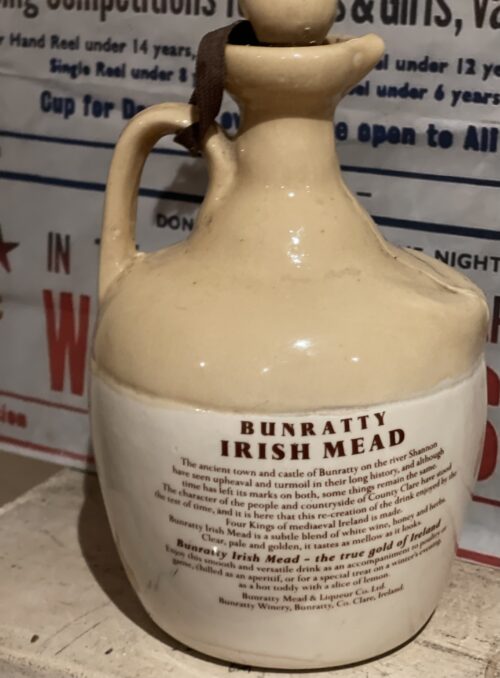
 26cm (empty)
26cm (empty)Bunratty Mead is a traditional wine, produced from an ancient Irish recipe of pure honey, fruit of the vine and natural herbs. It's a medium sweet wine, with a wide taste appeal, and suitable for all important occasions. As the drink of the ancient Celts, Mead derives much of its appeal through Irish Folklore, which is legendary of this mystical drink with strong attachments to Ireland.
In the days of old when knights were bold, the drink of choice was mead. Much more than an extraordinary legendary drink with strong attachments to Ireland, mead can be traced back as many centuries before Christ. It became the chief drink of the Irish and was often referred to in Gaelic poetry. Mead's influence was so great that the halls of Tara, where the High Kings of Ireland ruled, were called the house of the Mead Circle. Its fame spread quickly and soon a medieval banquet was not complete without it.
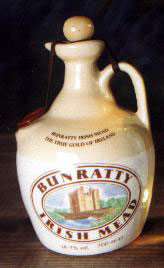

Even the church recognised the value of this fabulous drink. Legend has it that St. Finian lived for six days a week on bread and water, but on Sundays ate salmon and drank a full sup of mead. In addition, St. Bridget performed a miracle when mead could not be located for the king of Leinster. She blessed an empty vessel, which miraculously filled with Mead.
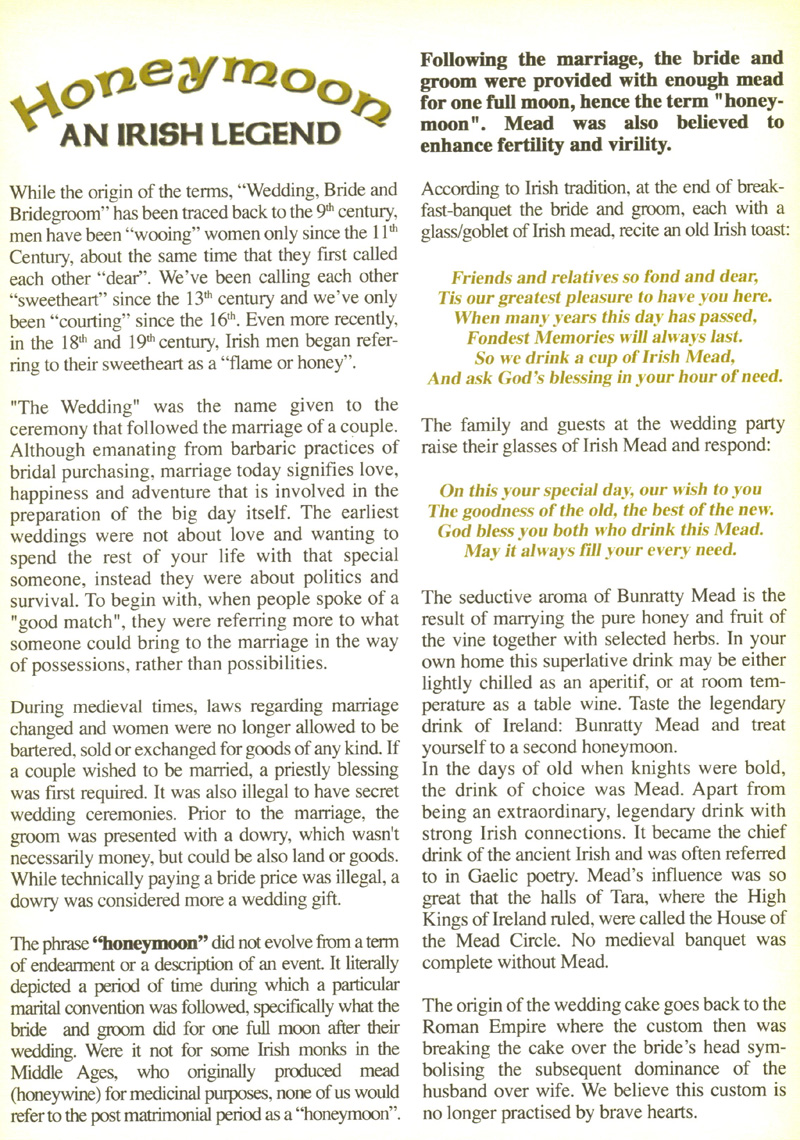
-

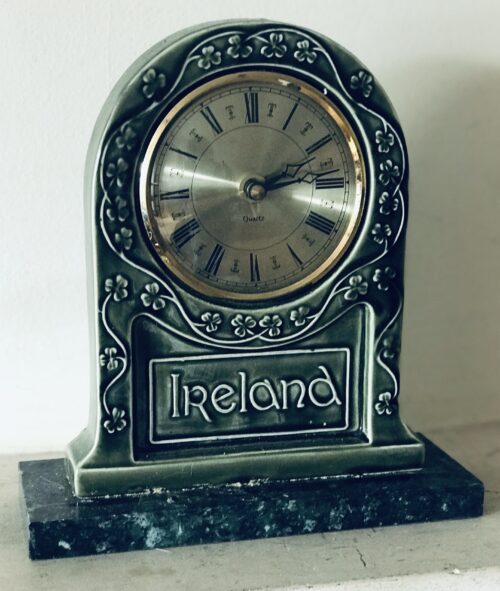 Quaint green ceramic clock with Irish theme,manufactured by Knock Pottery,Co Mayo. 23cm x 22cm x8cm Knock (Irish Cnoc Mhuire, 'Hill of the Virgin Mary') is a major international Catholic pilgrimage and prayer site. On August 21st, 1879, the Virgin Mary, St Joseph and St John the Evangelist, appeared on the south gable of Knock Parish Church. This Apparition was witnessed by fifteen local people, young and old. As a result, Knock became a major Irish pilgrimage site of prayer and worship. In the latter part of the 20th century Knock's popularity increased steadily, making it one of Europe's major Catholic Marian shrines, together with Lourdes and Fatima. Today this shrine is visited by one and a half million pilgrims annually. In 1979, Knock was visited by Pope John Paul II, to commemorate the centenary of the apparition. Mother Teresa of Calcutta visited the Shrine in June 1993 Monsignor James Horan was parish priest of Knock from 1967, until his death in 1986. In that period of his service to the parish of Knock, he accomplished some landmark achievements, amongst them the building of a new basilica in 1976, which can accommodate 10,000 people, and also the construction of Ireland West Airport Knock, which he saw completed in 1985. Monsignor Horan was also instrumental in organising the visit of Pope John Paul II to the shrine in 1979Knock Shrine is open all year round. The main pilgrimage season extends from the last Sunday in April until the second Sunday in October. The clock mechanism in good working order. Origins : Co Mayo Dimensions : 22cm x 21cm 4kg
Quaint green ceramic clock with Irish theme,manufactured by Knock Pottery,Co Mayo. 23cm x 22cm x8cm Knock (Irish Cnoc Mhuire, 'Hill of the Virgin Mary') is a major international Catholic pilgrimage and prayer site. On August 21st, 1879, the Virgin Mary, St Joseph and St John the Evangelist, appeared on the south gable of Knock Parish Church. This Apparition was witnessed by fifteen local people, young and old. As a result, Knock became a major Irish pilgrimage site of prayer and worship. In the latter part of the 20th century Knock's popularity increased steadily, making it one of Europe's major Catholic Marian shrines, together with Lourdes and Fatima. Today this shrine is visited by one and a half million pilgrims annually. In 1979, Knock was visited by Pope John Paul II, to commemorate the centenary of the apparition. Mother Teresa of Calcutta visited the Shrine in June 1993 Monsignor James Horan was parish priest of Knock from 1967, until his death in 1986. In that period of his service to the parish of Knock, he accomplished some landmark achievements, amongst them the building of a new basilica in 1976, which can accommodate 10,000 people, and also the construction of Ireland West Airport Knock, which he saw completed in 1985. Monsignor Horan was also instrumental in organising the visit of Pope John Paul II to the shrine in 1979Knock Shrine is open all year round. The main pilgrimage season extends from the last Sunday in April until the second Sunday in October. The clock mechanism in good working order. Origins : Co Mayo Dimensions : 22cm x 21cm 4kg -
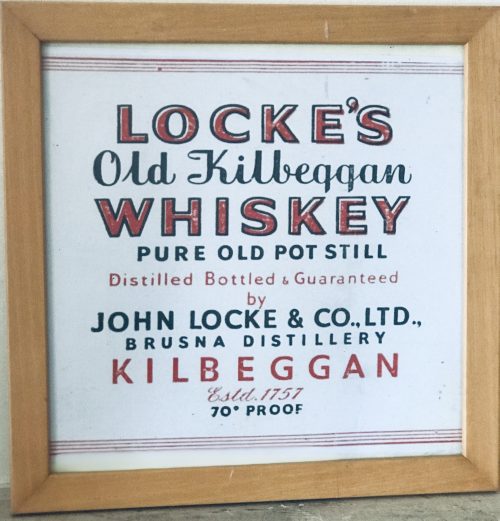
 Locke's Single Malt Old Irish Whiskey Advert Origins: Kilbeggan Co Westmeath Dimensions: 26cm x 26cm The Kilbeggan Distillery (formerly Brusna Distillery and Locke's Distillery) is an Irish whiskey distillery situated on the River Brosna in Kilbeggan, County Westmeath, Ireland. It is owned by Beam Suntory. A small pot still distillery, the licence to distil dates to 1757, a copy of which can be seen in the distillery. Similar to many Irish distilleries, Kilbeggan endured financial difficulties during the early 20th century, and ceased operations in 1957. However, the distillery was later refurbished, with distilling recommencing on-site in 2007. Noted devotees of the distillery's whiskeys include British Prime Minister Sir Winston Churchill, and Myles na gCopaleen, the Irish playwright.
Locke's Single Malt Old Irish Whiskey Advert Origins: Kilbeggan Co Westmeath Dimensions: 26cm x 26cm The Kilbeggan Distillery (formerly Brusna Distillery and Locke's Distillery) is an Irish whiskey distillery situated on the River Brosna in Kilbeggan, County Westmeath, Ireland. It is owned by Beam Suntory. A small pot still distillery, the licence to distil dates to 1757, a copy of which can be seen in the distillery. Similar to many Irish distilleries, Kilbeggan endured financial difficulties during the early 20th century, and ceased operations in 1957. However, the distillery was later refurbished, with distilling recommencing on-site in 2007. Noted devotees of the distillery's whiskeys include British Prime Minister Sir Winston Churchill, and Myles na gCopaleen, the Irish playwright.Early years
The distillery was founded in 1757 by Matthew MacManus, who may have distilled elsewhere before founding Kilbeggan.Although information about the early years of the distillery is scarce, documentation suggests that in its early years the distillery operated with a 232 gallon still, and an annual output of 1,500 gallons. By the early 19th century, the distillery was being run by a John and William Codd. In 1841, the distillery was put up for sale following the dissolution of the partnership between its then owners, William Codd and William Cuffee.The distillery at the time consisted of a brew house, still house with three pot stills (wash still: 8,000 gallons; low wine still, no. 1; 2,000 gallons; low wine still, no. 2: 1,500 gallons), run-room with five receivers, malt house, corn stores capable of storing 5,000 barrels, and oat-meal mills. Also listed in the sale were 400 tonnes of coal, and 10,000 boxes of turf - the latter reflecting the immense quantities of turf consumed at the distillery, so much so, that it was reported to have kept hundreds of poor people profitably employed in cutting, rearing, and drawing it to the town throughout the year.Locke's Distillery
In 1843, the distillery was taken over by John Locke, under whose stewardship the distillery flourished. Locke treated his staff well, and was held in high regard by both his workers and the people of the town. Informal records show that under Locke the distillery provided cottages for its employees, either for rent or purchase through a form of in-house mortgage scheme. In addition, all staff received a wagon load of coal at the start of each winter, the cost of which was deducted from salaries retrospectively on a weekly basis. Testimony of the respect with which he was held is offered by an incident in 1866. Following an accident on-site which had rendered a critical piece of equipment, the steam boiler, inoperable, the distillery had come to a standstill. With Locke unable to afford or obtain a loan to fund a replacement, the future of distillery lay in doubt.However, in a gesture of solidarity, the people of Kilbeggan came together and purchased a replacement boiler, which they presented to John Locke, along with the following public letter of appreciation, which was printed in several local newspapers at the time:An Address from the People of Kilbeggan to John Locke, Esq. Dear Sir - Permit us, your fellow townsmen, to assure of our deep and cordial sympathy in your loss and disappointment from the accident which occurred recently in your Distillery. Sincerely as we regret the accident, happily unattended with loss of life, we cannot but rejoice at the long-wished-for opportunity it affords us of testifying to you the high appreciation in which we hold you for your public and private worth. We are well aware that the restrictions imposed by recent legislation on that particular branch of Irish industry, with which you have been so long identified, have been attended with disastrous results to the trade, as is manifest in the long list of Distilleries now almost in ruins, and which were a few years ago centres of busy industry, affording remunerative employment to thousands of hands; and we are convinced the Kilbeggan Distillery would have long since swelled the dismal catalogue had it fallen into less energetic and enterprising hands. In such an event we would be compelled to witness the disheartening scene of a large number of our working population without employment during that period of the year when employment Is scarcest, and at the same time most essential to the poor. Independent then of what we owe you, on purely personal grounds, we feel we owe you a deep debt of gratitude for maintaining in our midst a manufacture which affords such extensive employment to our poor, and exercises so favourable an influence on the prosperity of the town. In conclusion, dear Sir, we beg your acceptance of a new steam boiler to replace the injured one, as testimony, inadequate though it is, of our unfeigned respect and esteems for you ; and we beg to present it with the ardent wish and earnest hope that, for many long years to come, it may contribute to enhance still more the deservedly high and increasing reputation of the Kilbeggan Distillery.
In a public response to mark the gift, also published in several newspapers, Locke thanked the people of Kilbeggan for their generosity, stating "...I feel this to be the proudest day of my life...". A plaque commemorating the event hangs in the distillery's restaurant today. In 1878, a fire broke out in the "can dip" (sampling) room of the distillery, and spread rapidly. Although, the fire was extinguished within an hour, it destroying a considerable portion of the front of the distillery and caused £400 worth of damage. Hundreds of gallons of new whiskey were also consumed in the blaze - however, the distillery is said to have been saved from further physical and financial ruin through the quick reaction of townsfolk who broke down the doors of the warehouses, and helped roll thousands of casks of ageing spirit down the street to safety. In 1887, the distillery was visited by Alfred Barnard, a British writer, as research for his book, "the Whiskey Distilleries of the United Kingdom". By then, the much enlarged distillery was being managed by John's sons, John Edward and James Harvey, who told Barnard that the distillery's output had more than doubled during the preceding ten years, and that they intended to install electric lighting.Barnard noted that the distillery, which he referred to as the "Brusna Distillery", named for the nearby river, was said to be the oldest in Ireland. According to Barnard, the distillery covered 5 acres, and employed a staff of about 70 men, with the aged and sick pensioned-off or assisted. At the time of his visit, the distillery was producing 157,200 proof gallons per annum, though it had the capacity to produce 200,000. The whiskey, which was sold primarily in Dublin, England, and "the Colonies", was "old pot still", produced using four pot stills (two wash stills: 10,320 / 8,436 gallons; and two spirit stills: 6,170 / 6,080 gallons), which had been installed by Millar and Company, Dublin. Barnard remarked that at the time of his visit over 2,000 casks of spirit were ageing in the distillery's bonded warehouses. In 1893, the distillery ceased to be privately held, and was converted a limited stock company, trading as John Locke & Co., Ltd., with nominal capital of £40,000.Decline and Closure
In the early part of the 20th century, Kilbeggan, like many Irish whiskey distilleries at the time, entered a period of decline. This was due to the combined effects of loss and hampering of market access - due to prohibition in the United States, the trade war with the British Empire, shipping difficulties during the world wars, and Irish Government export quotas; as well as competition from blended Scotch, and disruption to production during the Irish war of Independence. As a result, Kilbeggan was forced to cease production of new spirit for 7 years between 1924 and 1931, decimating the company's cash flow and finances.Most of the staff at the distillery were let go, and the distillery slowly sold off its stocks of aged whiskey. Distilling resumed in 1931, following the end of prohibition in the United States, and for a time the distillery's finances improved - with a loss of £83 in 1931, converted to a modest profit of £6,700 in 1939. In the 1920s, both of John sons passed away, John in 1920, and James in 1927, and ownership of the distillery passed to Locke's granddaughters, Mary Evelyn and Florence Emily.However, by then the distillery was in need to repair, with the turbulent economic conditions of the early 20th century having meant that no investment had been made in new plant since the 1890s. In 1947, the Lockes decided to put the distillery was put up for sale as a going concern. Although run down, the distillery had valuable stocks of mature whiskey, a valuable commodity in post-war Europe.An offer of £305,000 was received from a Swiss investor fronted by an Englishman, going by the name of Horace Smith.Their unstated interest, was not the business itself, but the 60,000 gallons of whiskey stocks, which they hoped to sell on the black market in England at £11 a gallon - thus, more than doubling their investment overnight. However, when they failed to come up with the deposit, the duo were arrested and promptly interrogated by Irish police. The Englishman, it turned out, was an impostor named Maximoe, who was wanted by Scotland Yard.]The Irish authorities placed Maximoe on a ferry back to England for extradition, but he jumped overboard and escaped with the help of unknown accomplices. An Irish opposition politician, Oliver J. Flanagan, subsequently alleged under parliamentary privilege that members of the governing Fianna Fáil political party were linked to the deal, accusing then Irish Taoiseach Éamon de Valera and his son of having accepted gold watches from the Swiss businessman. A tribunal of inquiry discounted the allegations but the damage contributed to Fianna Fáil's defeat in the 1948 election. In addition, as the scandal remained headline news in Ireland for several months, it discouraged interest from other investors in the distillery. Thus with no buyer found, operations continued at the distillery, with production averaging between 120,000 - 150,000 proof gallons per annum, and consumption running at between 15,000 - 20,000 barrels of barrel.In addition, although heavily indebted, investments were made in new plant and equipment. However, the death knell for the distillery came in April 1952, when the Irish Government introduced a 28% hike in the excise duties on spirits, causing a drastic decline in domestic whiskey sales. By November 1953, the distillery could not afford to pay the duty to release whiskey ordered for Christmas from bond, and production was forced to come to a halt. Although distilling had stopped, the firm struggled on until 27 November 1958, when a debenture issued in 1953 fell due, which the distillery could not afford to pay, forcing the bank to call in the receivers. Thus, bringing to an end 201 years of distilling in the town. In 1962, the distillery was purchased for £10,000 by Karl Heinz Moller, a German businessman, who owned a motor distribution company in Hamburg.Moller made a substantial profit on the deal, by selling off the whiskey stocks (about 100,000 gallons - worth tens of thousands of pounds alone) and a rare Mercedes Benz owned by the distillery. Much to the dismay of locals, Moller proceeded to convert the distillery into a pigsty, smashing thousands of Locke earthenware crocks (which would be worth a substantial amount at auction today) to create a hard-core base for the concrete floor. In 1969, the distillery was sold to Powerscreen, a firm which sold Volvo loading shovels, and in the early 1970s, the stills and worms were removed and sold for scrap.Distillery reopens
In 1982, almost thirty years after the distillery ceased operations, the Kilbeggan Preservation and Development Association was formed by locals in the town. Using funds raised locally, the Association restored the Distillery, and reopened it to the public as a whiskey distillery museum. Then, in 1987, the newly opened Cooley Distillery acquired the assets of Kilbeggan distillery, allowing Cooley to relaunch whiskeys under the Kilbeggan and Locke's Whiskey brands. Cooley later also took over the running of the museum, and began the process of re-establishing a working distillery on-site. Cooley were aided in the process by the fact that since the distillery's closure, each subsequent owner had faithfully paid the £5 annual fee to maintain the distilling licence. In 2007, the 250th anniversary of the distillery's founding, distillation recommenced at Kilbeggan. The official firing of the pot stills was witnessed by direct descendants of the three families, the McManuses, the Codds, and the Lockes, who had run the distillery during its 200 year distilling history. In a fitting nod to the long history of distilling at Kilbeggan, one of the two pot stills installed in the refurbished distillery was a 180-year old pot still, which had originally been installed at the Old Tullamore Distillery in the early 1800s.] It is the oldest working pot still producing whiskey in the world today. In 2010, with the installation of a mash tun and fermentation vats, Kilbeggan became a fully operational distillery once again.Present day
Today the distillery is known as Kilbeggan Distillery, and includes a restaurant, The Pantry Restaurant, and a 19th-century waterwheel that has been restored to working condition. The distillery can also be powered by a steam engine, which is in working condition but rarely used. It was installed to allow the distillery to continue operating in times of low water on the river. Prior to the recommencement of operations of Kilbeggan, the three brands associated with the distillery—Kilbeggan, Locke's Blend and Locke's Malt were produced at the Cooley Distillery in County Louth, before being transported to Kilbeggan, where they were to stored in a 200 year old granite warehouse. However, following recommencement of operations at Kilbeggan, new whiskey produced on-site has been sufficiently mature for market since around 2014. Since reopening, the distillery has launched a Kilbeggan Small Batch Rye, the first whiskey to be 100% distilled and matured on-site since the restoration was completed. Double-distilled, the whiskey is produced from a mash of malt, barley, and about 30% rye, said to reflect the traditional practice of using rye, which was common at 19th century Irish distilleries, but has since virtually died out. In late 2009, the distillery released small '3-pack' samples of its still-developing "new make spirit" at 1 month, 1 year, and 2 years of age (in Ireland, the spirit must be aged a minimum of three years before it can legally be called "whiskey"). The distillery's visitor centre was among the nominations in Whisky Magazine's Icons of Whisky visitor attraction category in 2008.Gallery
-

 Locke's Old Kilbeggan Pure Pot Still Whiskey Advert Origins: Kilbeggan Co Westmeath Dimensions: 32cm x 37cm The Kilbeggan Distillery (formerly Brusna Distillery and Locke's Distillery) is an Irish whiskey distillery situated on the River Brosna in Kilbeggan, County Westmeath, Ireland. It is owned by Beam Suntory. A small pot still distillery, the licence to distil dates to 1757, a copy of which can be seen in the distillery. Similar to many Irish distilleries, Kilbeggan endured financial difficulties during the early 20th century, and ceased operations in 1957. However, the distillery was later refurbished, with distilling recommencing on-site in 2007. Noted devotees of the distillery's whiskeys include British Prime Minister Sir Winston Churchill, and Myles na gCopaleen, the Irish playwright.
Locke's Old Kilbeggan Pure Pot Still Whiskey Advert Origins: Kilbeggan Co Westmeath Dimensions: 32cm x 37cm The Kilbeggan Distillery (formerly Brusna Distillery and Locke's Distillery) is an Irish whiskey distillery situated on the River Brosna in Kilbeggan, County Westmeath, Ireland. It is owned by Beam Suntory. A small pot still distillery, the licence to distil dates to 1757, a copy of which can be seen in the distillery. Similar to many Irish distilleries, Kilbeggan endured financial difficulties during the early 20th century, and ceased operations in 1957. However, the distillery was later refurbished, with distilling recommencing on-site in 2007. Noted devotees of the distillery's whiskeys include British Prime Minister Sir Winston Churchill, and Myles na gCopaleen, the Irish playwright.Early years
The distillery was founded in 1757 by Matthew MacManus, who may have distilled elsewhere before founding Kilbeggan.Although information about the early years of the distillery is scarce, documentation suggests that in its early years the distillery operated with a 232 gallon still, and an annual output of 1,500 gallons. By the early 19th century, the distillery was being run by a John and William Codd. In 1841, the distillery was put up for sale following the dissolution of the partnership between its then owners, William Codd and William Cuffee.The distillery at the time consisted of a brew house, still house with three pot stills (wash still: 8,000 gallons; low wine still, no. 1; 2,000 gallons; low wine still, no. 2: 1,500 gallons), run-room with five receivers, malt house, corn stores capable of storing 5,000 barrels, and oat-meal mills. Also listed in the sale were 400 tonnes of coal, and 10,000 boxes of turf - the latter reflecting the immense quantities of turf consumed at the distillery, so much so, that it was reported to have kept hundreds of poor people profitably employed in cutting, rearing, and drawing it to the town throughout the year.Locke's Distillery
In 1843, the distillery was taken over by John Locke, under whose stewardship the distillery flourished. Locke treated his staff well, and was held in high regard by both his workers and the people of the town. Informal records show that under Locke the distillery provided cottages for its employees, either for rent or purchase through a form of in-house mortgage scheme. In addition, all staff received a wagon load of coal at the start of each winter, the cost of which was deducted from salaries retrospectively on a weekly basis. Testimony of the respect with which he was held is offered by an incident in 1866. Following an accident on-site which had rendered a critical piece of equipment, the steam boiler, inoperable, the distillery had come to a standstill. With Locke unable to afford or obtain a loan to fund a replacement, the future of distillery lay in doubt.However, in a gesture of solidarity, the people of Kilbeggan came together and purchased a replacement boiler, which they presented to John Locke, along with the following public letter of appreciation, which was printed in several local newspapers at the time:An Address from the People of Kilbeggan to John Locke, Esq. Dear Sir - Permit us, your fellow townsmen, to assure of our deep and cordial sympathy in your loss and disappointment from the accident which occurred recently in your Distillery. Sincerely as we regret the accident, happily unattended with loss of life, we cannot but rejoice at the long-wished-for opportunity it affords us of testifying to you the high appreciation in which we hold you for your public and private worth. We are well aware that the restrictions imposed by recent legislation on that particular branch of Irish industry, with which you have been so long identified, have been attended with disastrous results to the trade, as is manifest in the long list of Distilleries now almost in ruins, and which were a few years ago centres of busy industry, affording remunerative employment to thousands of hands; and we are convinced the Kilbeggan Distillery would have long since swelled the dismal catalogue had it fallen into less energetic and enterprising hands. In such an event we would be compelled to witness the disheartening scene of a large number of our working population without employment during that period of the year when employment Is scarcest, and at the same time most essential to the poor. Independent then of what we owe you, on purely personal grounds, we feel we owe you a deep debt of gratitude for maintaining in our midst a manufacture which affords such extensive employment to our poor, and exercises so favourable an influence on the prosperity of the town. In conclusion, dear Sir, we beg your acceptance of a new steam boiler to replace the injured one, as testimony, inadequate though it is, of our unfeigned respect and esteems for you ; and we beg to present it with the ardent wish and earnest hope that, for many long years to come, it may contribute to enhance still more the deservedly high and increasing reputation of the Kilbeggan Distillery.
In a public response to mark the gift, also published in several newspapers, Locke thanked the people of Kilbeggan for their generosity, stating "...I feel this to be the proudest day of my life...". A plaque commemorating the event hangs in the distillery's restaurant today. In 1878, a fire broke out in the "can dip" (sampling) room of the distillery, and spread rapidly. Although, the fire was extinguished within an hour, it destroying a considerable portion of the front of the distillery and caused £400 worth of damage. Hundreds of gallons of new whiskey were also consumed in the blaze - however, the distillery is said to have been saved from further physical and financial ruin through the quick reaction of townsfolk who broke down the doors of the warehouses, and helped roll thousands of casks of ageing spirit down the street to safety. In 1887, the distillery was visited by Alfred Barnard, a British writer, as research for his book, "the Whiskey Distilleries of the United Kingdom". By then, the much enlarged distillery was being managed by John's sons, John Edward and James Harvey, who told Barnard that the distillery's output had more than doubled during the preceding ten years, and that they intended to install electric lighting.Barnard noted that the distillery, which he referred to as the "Brusna Distillery", named for the nearby river, was said to be the oldest in Ireland. According to Barnard, the distillery covered 5 acres, and employed a staff of about 70 men, with the aged and sick pensioned-off or assisted. At the time of his visit, the distillery was producing 157,200 proof gallons per annum, though it had the capacity to produce 200,000. The whiskey, which was sold primarily in Dublin, England, and "the Colonies", was "old pot still", produced using four pot stills (two wash stills: 10,320 / 8,436 gallons; and two spirit stills: 6,170 / 6,080 gallons), which had been installed by Millar and Company, Dublin. Barnard remarked that at the time of his visit over 2,000 casks of spirit were ageing in the distillery's bonded warehouses. In 1893, the distillery ceased to be privately held, and was converted a limited stock company, trading as John Locke & Co., Ltd., with nominal capital of £40,000.Decline and Closure
In the early part of the 20th century, Kilbeggan, like many Irish whiskey distilleries at the time, entered a period of decline. This was due to the combined effects of loss and hampering of market access - due to prohibition in the United States, the trade war with the British Empire, shipping difficulties during the world wars, and Irish Government export quotas; as well as competition from blended Scotch, and disruption to production during the Irish war of Independence. As a result, Kilbeggan was forced to cease production of new spirit for 7 years between 1924 and 1931, decimating the company's cash flow and finances.Most of the staff at the distillery were let go, and the distillery slowly sold off its stocks of aged whiskey. Distilling resumed in 1931, following the end of prohibition in the United States, and for a time the distillery's finances improved - with a loss of £83 in 1931, converted to a modest profit of £6,700 in 1939. In the 1920s, both of John sons passed away, John in 1920, and James in 1927, and ownership of the distillery passed to Locke's granddaughters, Mary Evelyn and Florence Emily.However, by then the distillery was in need to repair, with the turbulent economic conditions of the early 20th century having meant that no investment had been made in new plant since the 1890s. In 1947, the Lockes decided to put the distillery was put up for sale as a going concern. Although run down, the distillery had valuable stocks of mature whiskey, a valuable commodity in post-war Europe.An offer of £305,000 was received from a Swiss investor fronted by an Englishman, going by the name of Horace Smith.Their unstated interest, was not the business itself, but the 60,000 gallons of whiskey stocks, which they hoped to sell on the black market in England at £11 a gallon - thus, more than doubling their investment overnight. However, when they failed to come up with the deposit, the duo were arrested and promptly interrogated by Irish police. The Englishman, it turned out, was an impostor named Maximoe, who was wanted by Scotland Yard.]The Irish authorities placed Maximoe on a ferry back to England for extradition, but he jumped overboard and escaped with the help of unknown accomplices. An Irish opposition politician, Oliver J. Flanagan, subsequently alleged under parliamentary privilege that members of the governing Fianna Fáil political party were linked to the deal, accusing then Irish Taoiseach Éamon de Valera and his son of having accepted gold watches from the Swiss businessman. A tribunal of inquiry discounted the allegations but the damage contributed to Fianna Fáil's defeat in the 1948 election. In addition, as the scandal remained headline news in Ireland for several months, it discouraged interest from other investors in the distillery. Thus with no buyer found, operations continued at the distillery, with production averaging between 120,000 - 150,000 proof gallons per annum, and consumption running at between 15,000 - 20,000 barrels of barrel.In addition, although heavily indebted, investments were made in new plant and equipment. However, the death knell for the distillery came in April 1952, when the Irish Government introduced a 28% hike in the excise duties on spirits, causing a drastic decline in domestic whiskey sales. By November 1953, the distillery could not afford to pay the duty to release whiskey ordered for Christmas from bond, and production was forced to come to a halt. Although distilling had stopped, the firm struggled on until 27 November 1958, when a debenture issued in 1953 fell due, which the distillery could not afford to pay, forcing the bank to call in the receivers. Thus, bringing to an end 201 years of distilling in the town. In 1962, the distillery was purchased for £10,000 by Karl Heinz Moller, a German businessman, who owned a motor distribution company in Hamburg.Moller made a substantial profit on the deal, by selling off the whiskey stocks (about 100,000 gallons - worth tens of thousands of pounds alone) and a rare Mercedes Benz owned by the distillery. Much to the dismay of locals, Moller proceeded to convert the distillery into a pigsty, smashing thousands of Locke earthenware crocks (which would be worth a substantial amount at auction today) to create a hard-core base for the concrete floor. In 1969, the distillery was sold to Powerscreen, a firm which sold Volvo loading shovels, and in the early 1970s, the stills and worms were removed and sold for scrap.Distillery reopens
In 1982, almost thirty years after the distillery ceased operations, the Kilbeggan Preservation and Development Association was formed by locals in the town. Using funds raised locally, the Association restored the Distillery, and reopened it to the public as a whiskey distillery museum. Then, in 1987, the newly opened Cooley Distillery acquired the assets of Kilbeggan distillery, allowing Cooley to relaunch whiskeys under the Kilbeggan and Locke's Whiskey brands. Cooley later also took over the running of the museum, and began the process of re-establishing a working distillery on-site. Cooley were aided in the process by the fact that since the distillery's closure, each subsequent owner had faithfully paid the £5 annual fee to maintain the distilling licence. In 2007, the 250th anniversary of the distillery's founding, distillation recommenced at Kilbeggan. The official firing of the pot stills was witnessed by direct descendants of the three families, the McManuses, the Codds, and the Lockes, who had run the distillery during its 200 year distilling history. In a fitting nod to the long history of distilling at Kilbeggan, one of the two pot stills installed in the refurbished distillery was a 180-year old pot still, which had originally been installed at the Old Tullamore Distillery in the early 1800s.] It is the oldest working pot still producing whiskey in the world today. In 2010, with the installation of a mash tun and fermentation vats, Kilbeggan became a fully operational distillery once again.Present day
Today the distillery is known as Kilbeggan Distillery, and includes a restaurant, The Pantry Restaurant, and a 19th-century waterwheel that has been restored to working condition. The distillery can also be powered by a steam engine, which is in working condition but rarely used. It was installed to allow the distillery to continue operating in times of low water on the river. Prior to the recommencement of operations of Kilbeggan, the three brands associated with the distillery—Kilbeggan, Locke's Blend and Locke's Malt were produced at the Cooley Distillery in County Louth, before being transported to Kilbeggan, where they were to stored in a 200 year old granite warehouse. However, following recommencement of operations at Kilbeggan, new whiskey produced on-site has been sufficiently mature for market since around 2014. Since reopening, the distillery has launched a Kilbeggan Small Batch Rye, the first whiskey to be 100% distilled and matured on-site since the restoration was completed. Double-distilled, the whiskey is produced from a mash of malt, barley, and about 30% rye, said to reflect the traditional practice of using rye, which was common at 19th century Irish distilleries, but has since virtually died out. In late 2009, the distillery released small '3-pack' samples of its still-developing "new make spirit" at 1 month, 1 year, and 2 years of age (in Ireland, the spirit must be aged a minimum of three years before it can legally be called "whiskey"). The distillery's visitor centre was among the nominations in Whisky Magazine's Icons of Whisky visitor attraction category in 2008.Gallery
-
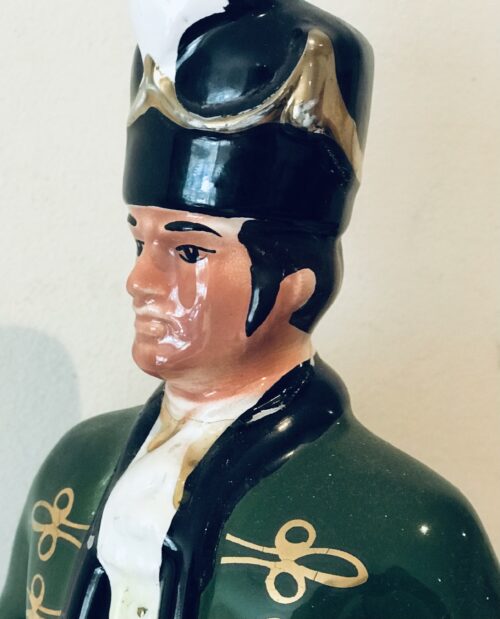
 A beautiful original porcelain example of an Irish Mist Decanter bottle ,the iconic Irish soldier dressed in the traditional Irish Brigade of the Austrian Army uniform of 1750. cm x cm x cm Irish Mist is a brown Whiskey Liqueur produced in Dublin, Ireland, by the Irish Mist Liqueur Company Ltd. In September 2010 it was announced that the brand was being bought by Gruppo Campari from William Grant, only a few months after Grants had bought it from the C&C Group. It is made from aged Irish whiskey, heather and clover honey, aromatic herbs, and other spirits, blended to an ancient recipe claimed to be 1,000 years old.Though it was once 80 US proof (40% alcohol per volume), Irish Mist is now 35% or 70 US proof. The bottle shape has also been changed from a "decanter" style to a more traditional whiskey bottle shape. It is currently available in more than 40 countries. Irish Mist was the first liqueur to be produced in Ireland when commercial production began in 1947 at Tullamore, County Offaly. Tullamore is the hometown of the Williams family who were the original owners of Irish Mist. The company history goes back to 1829 when the Tullamore Distillery was founded to produce Irish whiskey. In the mid-1940s Desmond E. Williams began the search for an alternative yet related product, eventually deciding to produce a liqueur based on the ancient beverage known as heather wine.In 1985 the Cantrell & Cochrane Group purchased the Irish Mist Liqueur Company from the Williams family. In the summer of 2010 Irish Mist and the entire spirit division of C&C was bought by William Grant of Scotland. In September 2010 they in turn sold Irish Mist to Gruppo Campari.Irish Mist is typically served straight up or on ice, but also goes with coffee, vodka, or cranberry juice. Per the makers, Irish Mist's most popular recipe is Irish Mist with Cola and Lime. A Rusty Mist is an ounce of Irish Mist with an ounce of Drambuie Scotch whisky liqueur.A Black Nail is made from equal parts Irish Mist and Irish whiskey. Origins :Co Offaly Dimensions : 50cm x 15cm 4kg
A beautiful original porcelain example of an Irish Mist Decanter bottle ,the iconic Irish soldier dressed in the traditional Irish Brigade of the Austrian Army uniform of 1750. cm x cm x cm Irish Mist is a brown Whiskey Liqueur produced in Dublin, Ireland, by the Irish Mist Liqueur Company Ltd. In September 2010 it was announced that the brand was being bought by Gruppo Campari from William Grant, only a few months after Grants had bought it from the C&C Group. It is made from aged Irish whiskey, heather and clover honey, aromatic herbs, and other spirits, blended to an ancient recipe claimed to be 1,000 years old.Though it was once 80 US proof (40% alcohol per volume), Irish Mist is now 35% or 70 US proof. The bottle shape has also been changed from a "decanter" style to a more traditional whiskey bottle shape. It is currently available in more than 40 countries. Irish Mist was the first liqueur to be produced in Ireland when commercial production began in 1947 at Tullamore, County Offaly. Tullamore is the hometown of the Williams family who were the original owners of Irish Mist. The company history goes back to 1829 when the Tullamore Distillery was founded to produce Irish whiskey. In the mid-1940s Desmond E. Williams began the search for an alternative yet related product, eventually deciding to produce a liqueur based on the ancient beverage known as heather wine.In 1985 the Cantrell & Cochrane Group purchased the Irish Mist Liqueur Company from the Williams family. In the summer of 2010 Irish Mist and the entire spirit division of C&C was bought by William Grant of Scotland. In September 2010 they in turn sold Irish Mist to Gruppo Campari.Irish Mist is typically served straight up or on ice, but also goes with coffee, vodka, or cranberry juice. Per the makers, Irish Mist's most popular recipe is Irish Mist with Cola and Lime. A Rusty Mist is an ounce of Irish Mist with an ounce of Drambuie Scotch whisky liqueur.A Black Nail is made from equal parts Irish Mist and Irish whiskey. Origins :Co Offaly Dimensions : 50cm x 15cm 4kg -
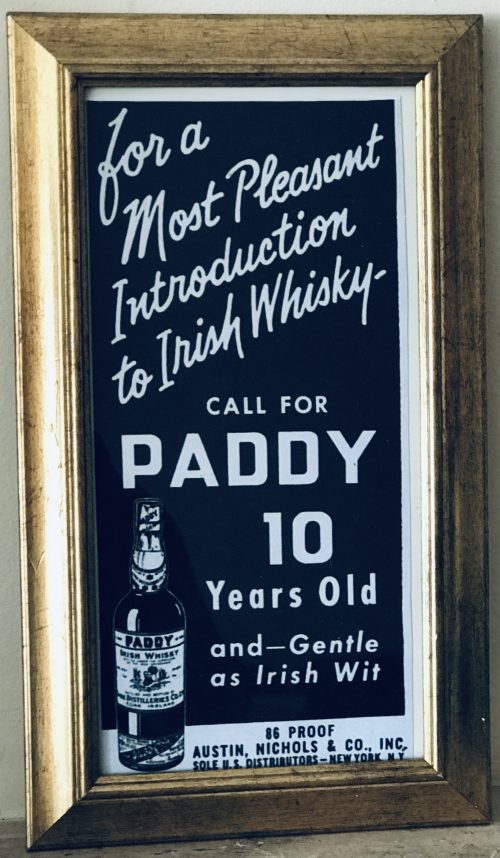
 Retro Paddy Old Irish Whiskey Advert Origins: Cork City Dimensions :38cm x 23cm
Retro Paddy Old Irish Whiskey Advert Origins: Cork City Dimensions :38cm x 23cm
Paddy is a brand of blended Irish whiskey produced by Irish Distillers, at the Midleton distillery in County Cork, on behalf of Sazerac, a privately held American company. Irish distillers owned the brand until its sale to Sazerac in 2016. As of 2016, Paddy is the fourth largest selling Irish whiskey in the WorldHistory The Cork Distilleries Company was founded in 1867 to merge four existing distilleries in Cork city (the North Mall, the Green, Watercourse Road, and Daly's) under the control of one group.A fifth distillery, the Midleton distillery, joined the group soon after in 1868. In 1882, the company hired a young Corkman called Paddy Flaherty as a salesman. Flaherty travelled the pubs of Cork marketing the company's unwieldy named "Cork Distilleries Company Old Irish Whiskey".His sales techniques (which including free rounds of drinks for customers) were so good, that when publicans ran low on stock they would write the distillery to reorder cases of "Paddy Flaherty's whiskey". In 1912, with his name having become synonymous with the whiskey, the distillery officially renamed the whiskey Paddy Irish Whiskey in his honour. In 1920s and 1930s in Ireland, whiskey was sold in casks from the distillery to wholesalers, who would in turn sell it on to publicans.To prevent fluctuations in quality due to middlemen diluting their casks, Cork Distilleries Company decided to bottle their own whiskey known as Paddy, becoming one of the first to do so. In 1988, following an unsolicited takeover offer by Grand Metropolitan, Irish Distillers approached Pernod Ricard and subsequently became a subsidiary of the French drinks conglomerate, following a friendly takeover bid. In 2016, Pernod Ricard sold the Paddy brand to Sazerac, a privately held American firm for an undisclosed fee. Pernod Ricard stated that the sale was in order "simplify" their portfolio, and allow for more targeted investment in their other Irish whiskey brands, such as Jameson and Powers. At the time of the sale, Paddy was the fourth largest selling Irish whiskey brand in the world, with sales of 200,000 9-litre cases per annum, across 28 countries worldwide. Paddy whiskey is distilled three times and matured in oak casks for up to seven years.Compared with other Irish whiskeys, Paddy has a comparatively low pot still content and a high malt content in its blend. Jim Murray, author of the Whiskey bible, has rated Paddy as "one of the softest of all Ireland's whiskeys".

Introduced 1879, renamed as Paddy in 1912 -

 26cm diametre Nazi dictator Adolf Hitler loved Irish folk music, and historical photographs reveal that famous Irish musician Sean Dempsey played for him in 1936. Dempsey, an uileann piper, was invited to play for Hitler and propaganda chief Joseph Goebbels during a visit to Berlin in 1936 after being told that Hitler was an Irish folk music fan. When he arrived to play, however, there was no room for him to sit, which he needed to do to play, and it looked like it would be canceled. However, Hitler jumped up and demanded that an S.S. member get down on his hands and knees and that Dempsey sit astride him while he played. Dempsey played what was described as a "haunting air" as Hitler listened with rapt attention. After he performed, Hitler presented him with a gold fountain pen while Goebbels clapped wildly. The bizarre scene was revealed for the first time in a 2010 exhibition of Irish photographs from that era called "Ceol na Cathra." The exhibition opened in Dublin and was collected by legendary fiddle player Mick O’Connor. Also in the exhibit were rare photographs from the early days of The Chieftains and Sean O'Riada, the father of modern Irish folk music.
26cm diametre Nazi dictator Adolf Hitler loved Irish folk music, and historical photographs reveal that famous Irish musician Sean Dempsey played for him in 1936. Dempsey, an uileann piper, was invited to play for Hitler and propaganda chief Joseph Goebbels during a visit to Berlin in 1936 after being told that Hitler was an Irish folk music fan. When he arrived to play, however, there was no room for him to sit, which he needed to do to play, and it looked like it would be canceled. However, Hitler jumped up and demanded that an S.S. member get down on his hands and knees and that Dempsey sit astride him while he played. Dempsey played what was described as a "haunting air" as Hitler listened with rapt attention. After he performed, Hitler presented him with a gold fountain pen while Goebbels clapped wildly. The bizarre scene was revealed for the first time in a 2010 exhibition of Irish photographs from that era called "Ceol na Cathra." The exhibition opened in Dublin and was collected by legendary fiddle player Mick O’Connor. Also in the exhibit were rare photographs from the early days of The Chieftains and Sean O'Riada, the father of modern Irish folk music. -

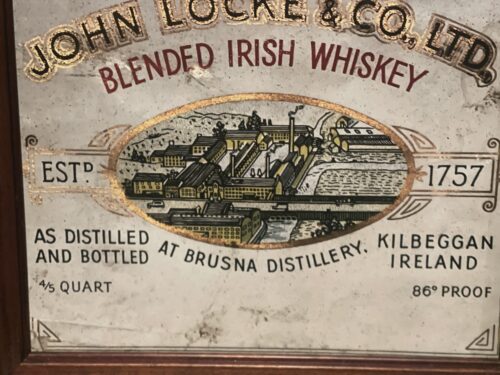 Locke's Old Kilbeggan Pure Pot Still Whiskey Advert Origins: Kilbeggan Co Westmeath Dimensions: 32cm x 37cm The Kilbeggan Distillery (formerly Brusna Distillery and Locke's Distillery) is an Irish whiskey distillery situated on the River Brosna in Kilbeggan, County Westmeath, Ireland. It is owned by Beam Suntory. A small pot still distillery, the licence to distil dates to 1757, a copy of which can be seen in the distillery. Similar to many Irish distilleries, Kilbeggan endured financial difficulties during the early 20th century, and ceased operations in 1957. However, the distillery was later refurbished, with distilling recommencing on-site in 2007. Noted devotees of the distillery's whiskeys include British Prime Minister Sir Winston Churchill, and Myles na gCopaleen, the Irish playwright.
Locke's Old Kilbeggan Pure Pot Still Whiskey Advert Origins: Kilbeggan Co Westmeath Dimensions: 32cm x 37cm The Kilbeggan Distillery (formerly Brusna Distillery and Locke's Distillery) is an Irish whiskey distillery situated on the River Brosna in Kilbeggan, County Westmeath, Ireland. It is owned by Beam Suntory. A small pot still distillery, the licence to distil dates to 1757, a copy of which can be seen in the distillery. Similar to many Irish distilleries, Kilbeggan endured financial difficulties during the early 20th century, and ceased operations in 1957. However, the distillery was later refurbished, with distilling recommencing on-site in 2007. Noted devotees of the distillery's whiskeys include British Prime Minister Sir Winston Churchill, and Myles na gCopaleen, the Irish playwright.Early years
The distillery was founded in 1757 by Matthew MacManus, who may have distilled elsewhere before founding Kilbeggan.Although information about the early years of the distillery is scarce, documentation suggests that in its early years the distillery operated with a 232 gallon still, and an annual output of 1,500 gallons. By the early 19th century, the distillery was being run by a John and William Codd. In 1841, the distillery was put up for sale following the dissolution of the partnership between its then owners, William Codd and William Cuffee.The distillery at the time consisted of a brew house, still house with three pot stills (wash still: 8,000 gallons; low wine still, no. 1; 2,000 gallons; low wine still, no. 2: 1,500 gallons), run-room with five receivers, malt house, corn stores capable of storing 5,000 barrels, and oat-meal mills. Also listed in the sale were 400 tonnes of coal, and 10,000 boxes of turf - the latter reflecting the immense quantities of turf consumed at the distillery, so much so, that it was reported to have kept hundreds of poor people profitably employed in cutting, rearing, and drawing it to the town throughout the year.Locke's Distillery
In 1843, the distillery was taken over by John Locke, under whose stewardship the distillery flourished. Locke treated his staff well, and was held in high regard by both his workers and the people of the town. Informal records show that under Locke the distillery provided cottages for its employees, either for rent or purchase through a form of in-house mortgage scheme. In addition, all staff received a wagon load of coal at the start of each winter, the cost of which was deducted from salaries retrospectively on a weekly basis. Testimony of the respect with which he was held is offered by an incident in 1866. Following an accident on-site which had rendered a critical piece of equipment, the steam boiler, inoperable, the distillery had come to a standstill. With Locke unable to afford or obtain a loan to fund a replacement, the future of distillery lay in doubt.However, in a gesture of solidarity, the people of Kilbeggan came together and purchased a replacement boiler, which they presented to John Locke, along with the following public letter of appreciation, which was printed in several local newspapers at the time:An Address from the People of Kilbeggan to John Locke, Esq. Dear Sir - Permit us, your fellow townsmen, to assure of our deep and cordial sympathy in your loss and disappointment from the accident which occurred recently in your Distillery. Sincerely as we regret the accident, happily unattended with loss of life, we cannot but rejoice at the long-wished-for opportunity it affords us of testifying to you the high appreciation in which we hold you for your public and private worth. We are well aware that the restrictions imposed by recent legislation on that particular branch of Irish industry, with which you have been so long identified, have been attended with disastrous results to the trade, as is manifest in the long list of Distilleries now almost in ruins, and which were a few years ago centres of busy industry, affording remunerative employment to thousands of hands; and we are convinced the Kilbeggan Distillery would have long since swelled the dismal catalogue had it fallen into less energetic and enterprising hands. In such an event we would be compelled to witness the disheartening scene of a large number of our working population without employment during that period of the year when employment Is scarcest, and at the same time most essential to the poor. Independent then of what we owe you, on purely personal grounds, we feel we owe you a deep debt of gratitude for maintaining in our midst a manufacture which affords such extensive employment to our poor, and exercises so favourable an influence on the prosperity of the town. In conclusion, dear Sir, we beg your acceptance of a new steam boiler to replace the injured one, as testimony, inadequate though it is, of our unfeigned respect and esteems for you ; and we beg to present it with the ardent wish and earnest hope that, for many long years to come, it may contribute to enhance still more the deservedly high and increasing reputation of the Kilbeggan Distillery.
In a public response to mark the gift, also published in several newspapers, Locke thanked the people of Kilbeggan for their generosity, stating "...I feel this to be the proudest day of my life...". A plaque commemorating the event hangs in the distillery's restaurant today. In 1878, a fire broke out in the "can dip" (sampling) room of the distillery, and spread rapidly. Although, the fire was extinguished within an hour, it destroying a considerable portion of the front of the distillery and caused £400 worth of damage. Hundreds of gallons of new whiskey were also consumed in the blaze - however, the distillery is said to have been saved from further physical and financial ruin through the quick reaction of townsfolk who broke down the doors of the warehouses, and helped roll thousands of casks of ageing spirit down the street to safety. In 1887, the distillery was visited by Alfred Barnard, a British writer, as research for his book, "the Whiskey Distilleries of the United Kingdom". By then, the much enlarged distillery was being managed by John's sons, John Edward and James Harvey, who told Barnard that the distillery's output had more than doubled during the preceding ten years, and that they intended to install electric lighting.Barnard noted that the distillery, which he referred to as the "Brusna Distillery", named for the nearby river, was said to be the oldest in Ireland. According to Barnard, the distillery covered 5 acres, and employed a staff of about 70 men, with the aged and sick pensioned-off or assisted. At the time of his visit, the distillery was producing 157,200 proof gallons per annum, though it had the capacity to produce 200,000. The whiskey, which was sold primarily in Dublin, England, and "the Colonies", was "old pot still", produced using four pot stills (two wash stills: 10,320 / 8,436 gallons; and two spirit stills: 6,170 / 6,080 gallons), which had been installed by Millar and Company, Dublin. Barnard remarked that at the time of his visit over 2,000 casks of spirit were ageing in the distillery's bonded warehouses. In 1893, the distillery ceased to be privately held, and was converted a limited stock company, trading as John Locke & Co., Ltd., with nominal capital of £40,000.Decline and Closure
In the early part of the 20th century, Kilbeggan, like many Irish whiskey distilleries at the time, entered a period of decline. This was due to the combined effects of loss and hampering of market access - due to prohibition in the United States, the trade war with the British Empire, shipping difficulties during the world wars, and Irish Government export quotas; as well as competition from blended Scotch, and disruption to production during the Irish war of Independence. As a result, Kilbeggan was forced to cease production of new spirit for 7 years between 1924 and 1931, decimating the company's cash flow and finances.Most of the staff at the distillery were let go, and the distillery slowly sold off its stocks of aged whiskey. Distilling resumed in 1931, following the end of prohibition in the United States, and for a time the distillery's finances improved - with a loss of £83 in 1931, converted to a modest profit of £6,700 in 1939. In the 1920s, both of John sons passed away, John in 1920, and James in 1927, and ownership of the distillery passed to Locke's granddaughters, Mary Evelyn and Florence Emily.However, by then the distillery was in need to repair, with the turbulent economic conditions of the early 20th century having meant that no investment had been made in new plant since the 1890s. In 1947, the Lockes decided to put the distillery was put up for sale as a going concern. Although run down, the distillery had valuable stocks of mature whiskey, a valuable commodity in post-war Europe.An offer of £305,000 was received from a Swiss investor fronted by an Englishman, going by the name of Horace Smith.Their unstated interest, was not the business itself, but the 60,000 gallons of whiskey stocks, which they hoped to sell on the black market in England at £11 a gallon - thus, more than doubling their investment overnight. However, when they failed to come up with the deposit, the duo were arrested and promptly interrogated by Irish police. The Englishman, it turned out, was an impostor named Maximoe, who was wanted by Scotland Yard.]The Irish authorities placed Maximoe on a ferry back to England for extradition, but he jumped overboard and escaped with the help of unknown accomplices. An Irish opposition politician, Oliver J. Flanagan, subsequently alleged under parliamentary privilege that members of the governing Fianna Fáil political party were linked to the deal, accusing then Irish Taoiseach Éamon de Valera and his son of having accepted gold watches from the Swiss businessman. A tribunal of inquiry discounted the allegations but the damage contributed to Fianna Fáil's defeat in the 1948 election. In addition, as the scandal remained headline news in Ireland for several months, it discouraged interest from other investors in the distillery. Thus with no buyer found, operations continued at the distillery, with production averaging between 120,000 - 150,000 proof gallons per annum, and consumption running at between 15,000 - 20,000 barrels of barrel.In addition, although heavily indebted, investments were made in new plant and equipment. However, the death knell for the distillery came in April 1952, when the Irish Government introduced a 28% hike in the excise duties on spirits, causing a drastic decline in domestic whiskey sales. By November 1953, the distillery could not afford to pay the duty to release whiskey ordered for Christmas from bond, and production was forced to come to a halt. Although distilling had stopped, the firm struggled on until 27 November 1958, when a debenture issued in 1953 fell due, which the distillery could not afford to pay, forcing the bank to call in the receivers. Thus, bringing to an end 201 years of distilling in the town. In 1962, the distillery was purchased for £10,000 by Karl Heinz Moller, a German businessman, who owned a motor distribution company in Hamburg.Moller made a substantial profit on the deal, by selling off the whiskey stocks (about 100,000 gallons - worth tens of thousands of pounds alone) and a rare Mercedes Benz owned by the distillery. Much to the dismay of locals, Moller proceeded to convert the distillery into a pigsty, smashing thousands of Locke earthenware crocks (which would be worth a substantial amount at auction today) to create a hard-core base for the concrete floor. In 1969, the distillery was sold to Powerscreen, a firm which sold Volvo loading shovels, and in the early 1970s, the stills and worms were removed and sold for scrap.Distillery reopens
In 1982, almost thirty years after the distillery ceased operations, the Kilbeggan Preservation and Development Association was formed by locals in the town. Using funds raised locally, the Association restored the Distillery, and reopened it to the public as a whiskey distillery museum. Then, in 1987, the newly opened Cooley Distillery acquired the assets of Kilbeggan distillery, allowing Cooley to relaunch whiskeys under the Kilbeggan and Locke's Whiskey brands. Cooley later also took over the running of the museum, and began the process of re-establishing a working distillery on-site. Cooley were aided in the process by the fact that since the distillery's closure, each subsequent owner had faithfully paid the £5 annual fee to maintain the distilling licence. In 2007, the 250th anniversary of the distillery's founding, distillation recommenced at Kilbeggan. The official firing of the pot stills was witnessed by direct descendants of the three families, the McManuses, the Codds, and the Lockes, who had run the distillery during its 200 year distilling history. In a fitting nod to the long history of distilling at Kilbeggan, one of the two pot stills installed in the refurbished distillery was a 180-year old pot still, which had originally been installed at the Old Tullamore Distillery in the early 1800s.] It is the oldest working pot still producing whiskey in the world today. In 2010, with the installation of a mash tun and fermentation vats, Kilbeggan became a fully operational distillery once again.Present day
Today the distillery is known as Kilbeggan Distillery, and includes a restaurant, The Pantry Restaurant, and a 19th-century waterwheel that has been restored to working condition. The distillery can also be powered by a steam engine, which is in working condition but rarely used. It was installed to allow the distillery to continue operating in times of low water on the river. Prior to the recommencement of operations of Kilbeggan, the three brands associated with the distillery—Kilbeggan, Locke's Blend and Locke's Malt were produced at the Cooley Distillery in County Louth, before being transported to Kilbeggan, where they were to stored in a 200 year old granite warehouse. However, following recommencement of operations at Kilbeggan, new whiskey produced on-site has been sufficiently mature for market since around 2014. Since reopening, the distillery has launched a Kilbeggan Small Batch Rye, the first whiskey to be 100% distilled and matured on-site since the restoration was completed. Double-distilled, the whiskey is produced from a mash of malt, barley, and about 30% rye, said to reflect the traditional practice of using rye, which was common at 19th century Irish distilleries, but has since virtually died out. In late 2009, the distillery released small '3-pack' samples of its still-developing "new make spirit" at 1 month, 1 year, and 2 years of age (in Ireland, the spirit must be aged a minimum of three years before it can legally be called "whiskey"). The distillery's visitor centre was among the nominations in Whisky Magazine's Icons of Whisky visitor attraction category in 2008.Gallery







